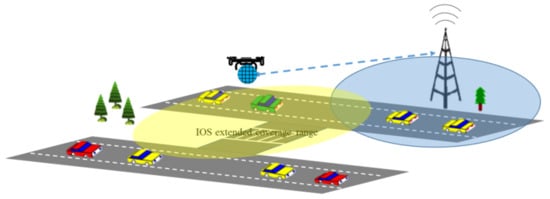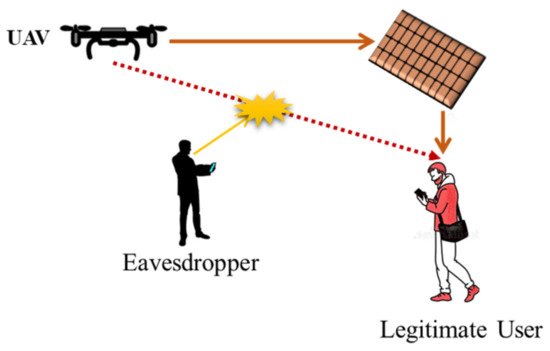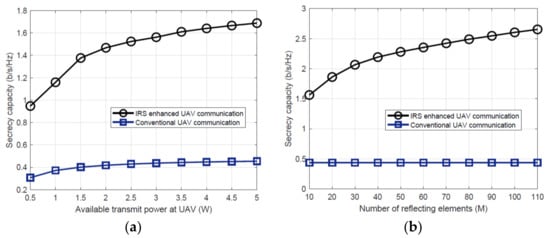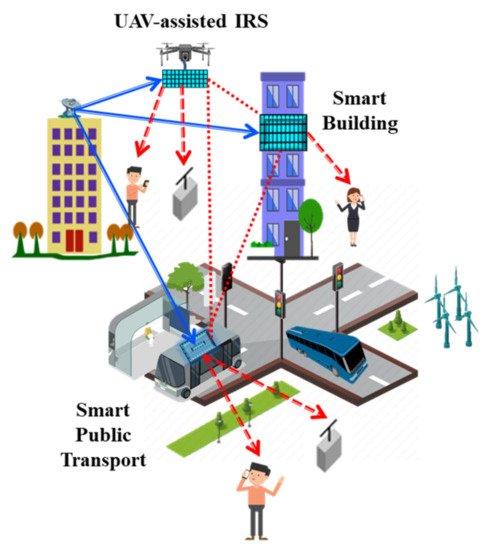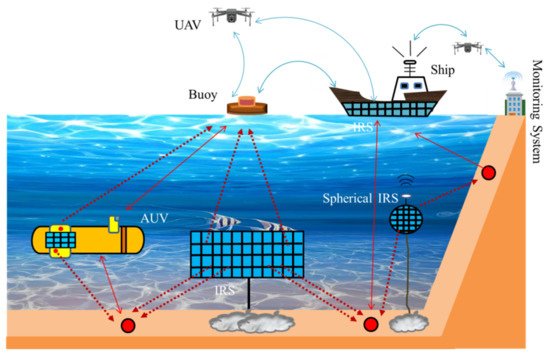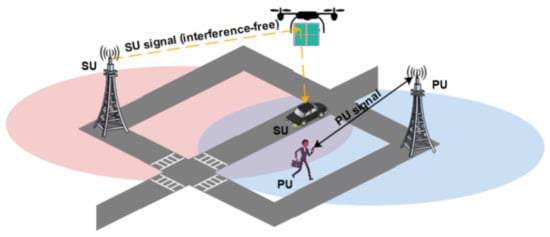1. IRS-Assisted UAV Communications for Extended Coverage
In future wireless networks, it is envisaged that aerial base station (ABS), aerial user equipment (AUE) and aerial relay (AR) will be the key enabler to achieve adaptive and dynamic coverage
[1][23]. As active aerial communication incurs energy overhead, so IRS is a promising alternative to overcome this drawback. In such scenario, a spherical type IRS can be used to control wireless propagation at intended locations, positions, heights, and depths. It is a novel design which can reflect signal in all directions. Spherical type IRS can cover dead zones by reflecting signal in multiple directions. This 360 degree coverage can further enhance the spectral efficiency. It can support multiple features due to potential rotational mobility of IRS. Moreover, UAVs can be used to carry IRS and support aerial communication. The UAV carrying IRS can further extend coverage at suitable heights. Similarly, the network coverage can be substantially improved in any intended direction or height by optimizing IRS phase shift and UAV location and trajectory.
Figure 10 presents an overview of IRS-assisted UAV for extended coverage.
Figure 10.
IRS-assisted UAV communication for extended coverage.
2. IRS-Assisted UAV Communications for Spectrum Sharing
IRS can significantly reduce interference when devices perform transmission considering same frequency slot. It makes IRS a promising candidate for spectrum sharing feature. Mostly used conventional approaches use cognitive radios and require an effective and reliable spectrum sharing technique to mitigate interference for primary users (PUs). However, it can only be attained at the expense of reliability and energy. IRS-assisted UAVs can improve the network capacity through spectrum sharing strategy. The potentials of IRS are empirically discussed to support spectrum sharing in indoor environment
[2][95]. In this study, IRS phase shift is used to control user interference while multiple access in spectrum sharing technique is used to increase capacity. In
[2][95], the authors introduce IRS-aided spectrum sharing technique to improve secondary users (SU) capacity while ensuring QoS for primary users (PU) through precisely optimizing IRS phase shift to enable channel diagonalization. These works can be further modified by smartly considering UAV’s potentials to optimize the performance of wireless networks in practical applications as shown in
Figure 211. Furthermore, in IRS-assisted UAV, it is essential to take account of impacts of specific parameters including altitude, latitude, and longitude of IRS phase shift to enhance network capacity.
Figure 211. IRS-assisted UAV for spectrum sharing [1]. IRS-assisted UAV for spectrum sharing [23].
3. IRS-Assisted UAV-Ground Wireless Networks
Although UAVs can establish LoS links for communication in multiple applications, they are critically prone to blockages. In addition, UAV-based ground communication is severely degraded by interference and vulnerable to eavesdropping. To mitigate these challenges, IRS can be involved to overcome obstacles by proving reflected links and supporting the communication for the intended users. Similarly, IRS has the potential capability to deteriorate the unintended signals at the users in order to prevent data leakage and avoid interference. In general, there lies a tradeoff to jointly configure the IRS phase shift to achieve these potentials. In a recent study
[3][24], authors report IRS-assisted UAV communication to enhance the quality of intended signals and suppress the unintended signals respectively. An overview of IRS-assisted UAV is presented in
Figure 312 in the presence of an eavesdropper to validate the potentials of IRS by improving the security of UAV-based ground networks.
Figure 312.
An IRS-assisted UAV system in the presence of eavesdropper.
4. IRS Enhanced PLS for UAV Communications
UAVs show the capabilities to enhance the physical layer security (PLS) for terrestrial wireless communication. It is conceived by establishing a dominant LoS link between ground and aerial nods. PLS can significantly support the received information at the legitimate users than eavesdroppers. Effective PLS can be achieved through various methods such as power allocation, jamming, coding, and signal processing techniques
[4][96]. PLS can effectively support defense, authentication, and key generation against eavesdropping. Some potential characteristics of PLS for security are low computation cost and packet size. Thus, PLS appear to be suitable candidate for energy constraint devices like UAVs and IoT terminals. UAVs can serve as ARs between legitimate nodes to weaken the communication link for eavesdroppers. Similarly, UAVs can send artificial noise towards eavesdroppers as friendly jammers to prevent legitimate users from any possible attack. IRS can also support data confidentiality of UAV communication through enhance secrecy rate. IRS passive reflecting elements can cause destructive reflection to restrict the eavesdropper and reduce the received SNR. Apart from security, IRS-assisted UAV can support reliable and energy efficient communication, which ultimately enhances the battery endurance of UAVs. In a recent study
[4][96], the authors validated the impacts on secrecy capacity by increasing both transmit power at the UAV and the number of reflecting elements at the IRS.
Figure 413a shows that by increasing the available transmission power at the UAV, the secrecy capacity also increases. It can be noticed that a significant gain can be achieved at lower values of transmit power. Similarly,
Figure 413b shows the impact of increasing the number of reflecting elements of IRS which results in enhanced secrecy capacity. The recent studies on IRS enhanced PLS for UAV communications were summarized in
Table 16.
Figure 413. Secrecy capacity of IRS-assisted UAV system (
a) impact of increasing transmit power at the UAV and (
b) impact of increasing number of increasing elements of IRS
[4][96].
Table 16. Existing works on IRS enabled PLS for UAV communication [4]. Existing works on IRS enabled PLS for UAV communication [96].
5. IRS-UAV Enabled Smart City
The idea of smart city has emerged from the harmonization of digital technologies and digital transformation of several ecosystems. In future, wireless networks must be smartly designed for optimal use of city resources. The concept of smart city can support accessibility to public services, advance digitalization of urban scenarios and advance monitoring capabilities of societal processes. In the foreseeable future, smart city elements will be more configurable and unified with the capability of self-management. Recently, “smart radio environment” was proposed in a study
[11][101] for better performance of wireless communication. It is closely related to the current ongoing developments of IRSs. Therefore, IRSs are envisioned to support required flexibility in “smart radio environment” or “smart communication environment” through energy and cost-efficient wireless propagation. Through employing IRSs, smart city ecosystems will be more configurable and adaptable, which will subsequently support easy installation of future wireless networks in urban environments and can further boost the interconnectivity among public and private applications. S. Kisseleff et al.
[12][102] discussed the innovative concept of IRS-assisted smart cities by considering several use cases, applications and key benefits. According to the authors, the basic architectural elements of a smart city will be autonomous vehicles, communication platforms, sensors/actuators, and services/applications. They also identified relevant applications as smart homes, smart buildings, smart factories, smart hospitals, smart billboards, and smart communications. In this study, the authors also investigate several research opportunities and future directions. They addressed key-enabling aspects if IRS-UAV assisted smart city requiring substantial research contributions in pilot decontamination, precoding for large multiuser networks, distributed operation and IRS phase control. It is envisaged that IRS-UAV assisted smart city will support enhanced security, better resource allocation and high QoS. An overview of IRS-UAV assisted smart city is presented in
Figure 514 where IRS can be installed at various sports such as mobile vehicles, UAVs, or fixed buildings. Some key benefits of using IRS-UAV in smart city are reduced energy consumption, smart communication, and high coverage. It can also tackle health, environmental, and ecological concerns with the proliferation of wireless technologies, specifically operating in high spectrum mmWave and THz bands and relieving human exposure to harmful RF radiations.
Figure 514. An overview of IRS-empowered UAV in smart cities (modified from [6]). An overview of IRS-empowered UAV in smart cities (modified from [76]).
6. IRS-Assisted UAV Vehicular Communication
Vehicular networks are extensively investigated to feature cutting-edge applications like intelligent transportation systems (ITS) and autonomous or self-driving vehicles. The vehicular networks are expected to offer reliable communication, low latency, and high data rate for ITS. Multiple applications of vehicular communication have been studied for autonomous, control, safety, and comfort-oriented features. For example, laser imaging detection and ranging (LIDAR) technology is being used in vehicular communication for securing Gb/s data rates. Researchers have also reported 10–300 GHZ mmWave for vehicular communications
[13][103]. However, mmWave communication is highly vulnerable to obstacles and high path loss. Moreover, transmission outage and beam tracking are not yet fully explored in mmWave communication. Furthermore, extreme narrow beams of mmWave lead to critical problems of secrecy information leakage and legitimate user blockage due to misalignment. THz communication can be another future technology for terabit vehicular networks in the domain of wireless networked smart automobiles. The THz beam’s alignment and stability can be hampered by the dense mobility of people and fluctuating congested traffic. To mitigate these challenges and to ensure reliable communication, IRS has been used as a cost-effective solution to extend coverage, reduce blockage and strengthen signal quality by passive reflecting elements. In order to support THz beam training and tracking in traffic congested areas, the mobile IRS carried by UAVs can help in traffic flow. The IRS carried by UAV can be positioned at different places, positions, and heights. In order to ensure a steady, real-time and high-speed THz communication, vehicles can pick cooperative IRS-UAV on blockage conditions at different places. It is envisaged that IRS- assisted UAV communication can support traffic monitoring, traffic accident prediction and avoid traffic congestion. In
[14][104], AU Makarfi et al. proposed IRS-assisted vehicular network to enhance PLS. The authors evaluated the performance of proposed architecture in terms of secrecy outage probability (SOP) and average secrecy capacity (ASC). The authors also studied the impact of several parameters and presented analytical expressions for the two performance metrics. In
[15][105], J. Wang et al. briefly discussed outage analysis for IRS-aided vehicular communication. The authors derive the numerical expression for outage probability by using central limit theorem and series expansion. The presented results indicate that IRS can effectively reduce the outage probability for vehicles located in its vicinity. Better performance can be further achieved by using a higher number of reflecting elements.
7. IRS-Assisted UAV Communication in IoUT
In underwater medium, optical and electromagnetic (EM) waves restricted to a short range while acoustic waves are used to achieve larger range in the context of Internet of Underwater Things (IoUT). On the other hand, acoustic communication is critically vulnerable to water species, water streams, suspended particles, and scattering at uneven surfaces. It also suffers from high path loss and significantly reduces the effective data rates. To tackle these shortcomings, IRS has been proposed as a viable solution. An application scenario of IRS-assisted UAV communication is presented in
Figure 615 for underwater applications. IRS can significantly reduce the multipath effect through beam steering. By optimizing IRS reflection elements, frequency selectivity can be reduced which leads to improved signal bandwidth. Below the water surface, IRS can be places in different geometries and locations. IRS can be located on the seashore, and can be installed on a ship or moving AUVs. AUVs can be preferred to carry IRS to preserve control on the smart environment and reduce any vulnerability. This smart integration of IRSs and AUVs can support better performance through dynamic mobility of AUVs and beam steering through IRS phase shift
[16][106]. Furthermore, UAVs can fly above the water surface to gather data from ships or buoys and transmit to remote monitoring systems. IRS-assisted UAV communication requires further research efforts to fully realize this strategy to support smart ocean transportation, harbor monitoring, disaster prediction, data collection, and underwater communication.
Figure 615. IoUT assisted by IRS-assisted UAV, motivated by [17]. IoUT assisted by IRS-assisted UAV, motivated by [107].
8. Cellular Connected UAVs
UAVs can be regarded as mobile relaying systems or virtual base stations which can be installed in various applications in multiple ways to support large scale coverage of B5G and 6G wireless networks. B5G and 6G networks are planned to deploy the terahertz communication band in order to achieve enhanced traffic between UAVs and users as well as BSs to fully harness the capabilities of UAVs. UAV cause severe interference from/to a massive number of co-channel BSs. However, due to the observable characteristics of air medium, THz communications, which rely on high power beamforming to combat challenges like fading, are highly vulnerable to mutual interference, consequently reducing transmission performance. In such conditions, IRS can be installed to smartly control the beam’s direction from the base station to ensure a variety of UAV connections. It provides as easy technique to control the reflection angel of incident signals to achieve propagation in a desired direction. Primarily IRS is integrated on roof or outer walls of buildings in urban environments. It can significantly enhance the interconnectivity of air-to-ground communication while preventing from multi-UAVs interference by introducing it into the BS beamforming scenario. In a recent study
[18][108], authors introduced an efficient scheme to mitigate interference by deploying IRSs near the BSs. Particularly, in the uplink, IRS passive beamforming support to enhance/suppress the UAV interference to facilitate the linear or non-linear interference mitigation at each BS. While in the downlink, the IRS passive beamforming can suppress interference of BS to the UAV. The presented results outperform benchmark schemes and provide significant design insights for IRS-assisted UAV communication in cellular networks.
9. UAV Placement/Trajectory Optimization
For terrestrial IRS, the UAV trajectory/position should be jointly optimized with the IRS passive beamforming, which is a new critical issue to be addressed.
Suppose first the 3D UAV deployment design for quasistatic UAVs. For urban areas with high rise dense buildings, the UAV is required to be located at a sufficient high altitude in order to establish LoS links with the ground users. However, increasing the altitude for UAV leads to high path loss, which brings a basic tradeoff between LoS probability and path loss. Interestingly, IRS can be deployed to alleviate this tradeoff. For instance, by integrating an IRS near the cell-edge users having low LoS probability with the UAV, the UAV altitude can be significantly reduced. This, therefore, supports reducing the link distance between the users and UAV. As a result, it also reduced the path loss, while maintaining the rate performance of IRS-aided users. Moreover, for high mobility UAVs, the UAVs trajectory should be jointly optimized with the IRS passive beamforming to gain the optimal performance. Usually, IRS performs well when it is located near the transmitter or receiver by minimizing the product distance path loss. It offers new insights for UAV trajectory to be optimized for IRS-assisted communication. For instance, when IRS is installed near ground-based users, there are other ground users which are not located in IRS’s coverage range. To enhance the minimum data collection rate, the UAV without IRS is required to fly towards every user to enhance the communication channel. On the other hand, with deployed IRS, the UAV is not required to fly towards IRS-assisted users and, thus, can spend more time to serve other network users. Alternatively, IRSs can also be integrated near the UAV location where UAVs are installed; thus, LoS links with the target ground users can be established. In such case, the UAV can visit the nearby IRSs without visiting the far-away users, hence reducing the flight-time and propulsion energy consumption for UAVs
[19][25].
10. IRS-Assisted UAV Communication in Underground Scenario
To satisfy the requirements of exceptional wireless communication service at anytime and anywhere, the high-speed and high-reliability data services in tunnel, e.g., mine tunnels, road tunnels, and subway tunnels, are required
[20][109]. However, restricted by Snell’s law, the blockages (such as rockfall or mining equipment due to geological hazards) in underground scenario or tunnels can cause ray-link blocking. The mitigation of these blockages in tunnels is highly important to ensure reliable communication for search and rescue tasks in case of tunnel disaster. To overcome such challenges, IRS is proposed to mitigate the challenge of signal blocking in blocked tunnels or mines
[21][110].
One of the internet-of-underground-things’ (IoUgT’s) primary application scenarios is the installation of sensor nodes in mines and tunnels. The uncontrolled reflections from the tunnel or mine walls and dispersion at the borders of the walls provide the biggest obstacle to the propagation of EM signals. This causes the degraded performance of network’s connection and signal quality. This problem may be solved by installing IRSs in the tunnel’s walls and ceiling, which will increase the directivity of signal transmission by guiding the signal in the direction of the passageway. Additionally, as was previously indicated, the earth may somewhat absorb the signals, meaning that each reflection may add to the overall route loss. However, in order to prevent further losses that would otherwise make the usage of IRS inefficient, IRSs are normally constructed with the maximum reflection coefficient. Due to the fact that the IoUgT is not moving, the passage map can be used to estimate the ideal position and rough values of the phase shifts. Moreover, UAVs can also be used to support in such underground scenarios such as establishing communication link, video shooting, and capturing images in search and rescue missions.
11. IRS-Assisted UAV Communication in Smart Industry
The Industrial Internet of Things (IIoT) bridges the physical and digital worlds to improve productivity and efficiency in smart manufacturing
[22][111]. The IIoT links millions of industrial entities to the internet in order to ensure efficient productivity and reliability. This architecture is a component of the broader technological advancement known as Industry 4.0. The integration of smart technologies will turn conventional industrial control and automation techniques into cyber-physical manufacturing units.
Industrial wireless communication systems are highly vulnerable to thick building structures, room dimensions, arbitrary mobility of objects, EM interference, and metallic structures. In contrast, full industrial automation needs low latency and ultra-reliability to support efficient mission-critical industrial applications. Furthermore, human–machine interaction in Industry 5.0 will lead to more complexity. Similarly, the growing demand of several emerging services in innovative industrial sectors such as holographic control display and augmented reality (AR) or virtual reality (VR) maintenance will create more challenges in future industries. To overcome the communication challenges of such emerging services, Industry 5.0 needs to integrate promising technologies including efficient energy harvesting, advanced localization, terahertz, and mmWave communications
[22][111].
To overcome aforementioned impediments and meet the requirements of future smart manufacturing industries, IRS can be a viable solution. IRS can be used to steer the signals towards target nodes and avoiding obstacles. IRS can be used to mitigate the interference caused by several production processes. Moreover, some manufacturing processes and machines are mobile and several machines are required to make same copies of specific products. In such cases, IRS-assisted UAV network can be used to support these manufacturing services. IRS-assisted UAV system will have a broader view of manufacturing process.
